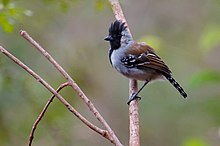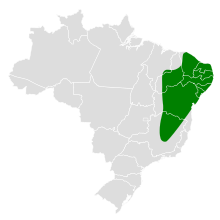| Silvery-cheeked antshrike | |
|---|---|

| |
| Conservation status | |
 Least Concern (IUCN 3.1) | |
| Scientific classification | |
| Domain: | Eukaryota |
| Kingdom: | Animalia |
| Phylum: | Chordata |
| Class: | Aves |
| Order: | Passeriformes |
| Family: | Thamnophilidae |
| Genus: | Sakesphoroides Grantsau, 2010 |
| Species: | S. cristatus |
| Binomial name | |
| Sakesphoroides cristatus (Wied, 1831) | |

| |
| Synonyms | |
|
Sakesphorus cristatus | |
The silvery-cheeked antshrike (Sakesphoroides cristatus) is a species of bird in subfamily Thamnophilinae of family Thamnophilidae, the "typical antbirds". It is endemic to Brazil.
Taxonomy and systematics
The silvery-cheeked antshrike was originally described as Turdus cristatus. and was later transferred to genus Sakesphorus. Its transfer to the new genus Sakesphoroides was proposed in 2010 based on the species' distinctive morphology. It uniqueness was confirmed by a genetic study published in 2010. Based on that study, the South American Classification Committee of the American Ornithological Society, the International Ornithological Congress, and the Clements taxonomy quickly moved the silvery-cheeked antshrike to Sakesphoroides. However, as of December 2023 BirdLife International's Handbook of the Birds of the World retained it in Sakesphorus.
The silvery-cheeked antshrike is the only member of genus Sakesphoroides and has no subspecies.
Description
The silvery-cheeked antshrike is about 14 cm (5.5 in) long. Both sexes have a crest. Adult males have a black forehead, crest, front of the face, throat, and breast center. The rest of their head and underparts are grayish white. Their back is brown. Their wings are black with white tips on the coverts and cinnamon edges on the flight feathers. Their tail is black with white spots and feather tips. Adult females have a rufous forehead, crest, and crown. The rest of their head and their underparts are pale buffy brown. The back is brown like the male's. Their wings are brown with white tips on the coverts and cinnamon edges on the flight feathers. Their tail is rufous-brown with no white.
Distribution and habitat
The silvery-cheeked antshrike is found in northeastern Brazil from Ceará and central and western Rio Grande do Norte south through southeastern Piauí, western Pernambuco, and inland Bahia into central Minas Gerais. It inhabits the understorey to mid-storey of deciduous forest and arid caatinga, and also the ecotone between deciduous and ridgetop evergreen forest. It favors areas where the forest has a closed canopy, such as mata-de-cipó. In elevation it ranges from sea level to 1,100 m (3,600 ft).
Behavior
Movement
The silvery-cheeked antshrike is believed to be a year-round resident throughout its range.
Feeding
The silvery-cheeked antshrike's diet includes insects and other arthropods; it favors ants and termites, and during the breeding season caterpillars. It mostly forages singly or in pairs and sometimes as a member of a mixed-species feeding flock. It typically forages from the ground to 2 m (7 ft) above it but also as high as 10 m (30 ft). It captures prey mostly by reaching up from the ground or a perch to glean from leaves, vines, and branches. It also pounces onto prey from a perch to the ground, and less often hitches its way up branches and through vine tangles.
Breeding
Nothing is known about the silvery-cheeked antshrike's breeding biology.
|
Songs and calls Listen to silvery-cheeked antshrike on xeno-canto |
Vocalization
The silvery-cheeked antshrike's song is a "short series of chopped, nasal notes, accelerating and trailing off to a growling sound" and lasting three to four seconds. Its calls include a " deep clear whistle, and more abrupt clear note sometimes repeated rapidly 3–4 times".
Status
The IUCN has assessed the silvery-cheeked antshrike as being of Least Concern. It has a large range. Its population size is not known and is believed to be decreasing. No immediate threats have been identified. It is considered fairly common across its range and occurs in one national park. "Mata-de-cipó and taller caatinga woodlands are habitats under increasing threat from agricultural conversion, grazing, and cutting for firewood."
References
- ^ BirdLife International (2016). "Silvery-cheeked Antshrike Sakesphorus cristatus". IUCN Red List of Threatened Species. 2016: e.T22701257A93820228. doi:10.2305/IUCN.UK.2016-3.RLTS.T22701257A93820228.en. Retrieved 26 February 2024.
- ^ Gill, Frank; Donsker, David; Rasmussen, Pamela, eds. (January 2024). "Antbirds". IOC World Bird List. v 14.1. Retrieved January 4, 2024.
- Prince of Wied-Neuwied, Maximilian (1830). Beiträge zur Naturgeschichte von Brasilien (in German). Vol. III. Weimar. p. 1002.
- ^ Remsen, J. V., Jr., J. I. Areta, E. Bonaccorso, S. Claramunt, G. Del-Rio, A. Jaramillo, D. F. Lane, M. B. Robbins, F. G. Stiles, and K. J. Zimmer. Version 26 November 2023. A classification of the bird species of South America. American Ornithological Society. https://www.museum.lsu.edu/~Remsen/SACCBaseline.htm retrieved November 27, 2023
- Grantsau, R. (2010). Guia Completo para Identificação das Aves do Brasil. Vols. 1 and 2. Vento Verde Editora, São Carlos, Brazil. In Portuguese.
- Bravo, G.A.; Whitney, B.M.; Belmonte-Lopes, R.; Bornschein, M.R.; Aristizábal, N.; Beco, R.; Battilana, J.; Naka, L.N.; Aleixo, A.; Pie, M.R.; Silveira, L.F. (2021). "Phylogenomic analyses reveal non-monophyly of the antbird genera Herpsilochmus and Sakesphorus (Thamnophilidae), with description of a new genus for Herpsilochmus sellowi". Ornithology. 138 (3). doi:10.1093/ornithology/ukab025.
- "IOC World Bird List 12.1". IOC World Bird List Datasets. doi:10.14344/ioc.ml.12.1. S2CID 246050277. Retrieved 2022-01-29.
- Clements, J. F., P.C. Rasmussen, T. S. Schulenberg, M. J. Iliff, T. A. Fredericks, J. A. Gerbracht, D. Lepage, A. Spencer, S. M. Billerman, B. L. Sullivan, and C. L. Wood. 2023. The eBird/Clements checklist of birds of the world: v2023. Downloaded from https://www.birds.cornell.edu/clementschecklist/download/ retrieved October 28, 2023
- HBW and BirdLife International (2023). Handbook of the Birds of the World and BirdLife International digital checklist of the birds of the world. Version 8. Available at: http://datazone.birdlife.org/userfiles/file/Species/Taxonomy/HBW-BirdLife_Checklist_v8_Dec23.zip retrieved December 28, 2023
- ^ Zimmer, K. and M.L. Isler (2022). Silvery-cheeked Antshrike (Sakesphoroides cristatus), version 1.1. In Birds of the World (N. D. Sly, Editor). Cornell Lab of Ornithology, Ithaca, NY, USA. https://doi.org/10.2173/bow.sicant1.01.1 retrieved February 26, 2024
- ^ van Perlo, Ber (2009). A Field Guide to the Birds of Brazil. New York: Oxford University Press. pp. 232–233. ISBN 978-0-19-530155-7.
| Taxon identifiers | |
|---|---|
| Sakesphorus cristatus |
|

